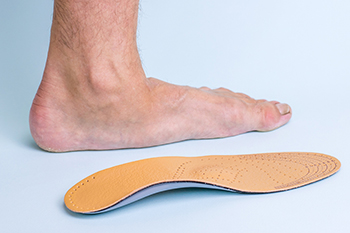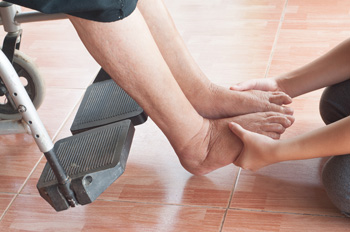Connect With Us
Blog
Items filtered by date: April 2022
Dealing With a Dislocated Toe

The most common cause of a dislocated toe is direct injury, either bumping into something solid or dropping something heavy on it. You most likely will feel extreme pain at the time of the injury, it will be hard to bend, or even move the toe; and it will swell, become bruised or lose feeling. Sometimes a loose ligament will cause a toe to dislocate, which is extremely painful. Avoid trying to pop the toe into place yourself, as this may cause further injury. The first thing to do is stop further activity, elevate the foot, immobilize it, and apply ice. Next, make an appointment with a podiatrist immediately. An X-ray may be required, followed by manipulating the bones back into place. Followup treatments include strapping the injured toe to the one next to it, alternating ice and heat, undergoing whirlpool treatments, and doing strengthening exercises. A podiatrist can properly diagnose the severity of your toe injury and propose the proper treatment plan for you.
A broken toe can be very painful and lead to complications if not properly fixed. If you have any concerns about your feet, contact one of our podiatrists from New England Foot and Ankle. Our doctors will treat your foot and ankle needs.
What to Know About a Broken Toe
Although most people try to avoid foot trauma such as banging, stubbing, or dropping heavy objects on their feet, the unfortunate fact is that it is a common occurrence. Given the fact that toes are positioned in front of the feet, they typically sustain the brunt of such trauma. When trauma occurs to a toe, the result can be a painful break (fracture).
Symptoms of a Broken Toe
- Throbbing pain
- Swelling
- Bruising on the skin and toenail
- The inability to move the toe
- Toe appears crooked or disfigured
- Tingling or numbness in the toe
Generally, it is best to stay off of the injured toe with the affected foot elevated.
Severe toe fractures may be treated with a splint, cast, and in some cases, minor surgery. Due to its position and the pressure it endures with daily activity, future complications can occur if the big toe is not properly treated.
If you have any questions please feel free to contact one of our offices located in Chelmsford and Newburyport, MA . We offer the newest diagnostic and treatment technologies for all your foot and ankle needs.
Can Obesity Cause Flat Feet?

The feet, and the arch, bear the body’s weight, and provide support and shock absorption. The arch is composed of several different structures, with the ligaments providing the lion’s share of stability and support. Excessive forces placed on the feet due to obesity can change the foot’s structure, negatively affecting the ligaments of the arch, and even causing flat feet in many overweight people. Studies even suggest that the degree of an overweight person’s flat footedness is directly correlated to their level of obesity, with a higher Body Mass Index (BMI) correlated with a lower plantar arch height. People with flat feet might experience complications such as plantar fasciitis, muscle cramping, arthritis, Achilles Tendonitis, and other forms of foot discomfort or pain. A podiatrist can help anyone, regardless of weight, who is experiencing discomfort from flat feet with custom orthotic devices, supportive shoes, stretching exercises and stretches, physical therapy, pain management medication and more.
Flatfoot is a condition many people suffer from. If you have flat feet, contact one of our podiatrists from New England Foot and Ankle. Our doctors will treat your foot and ankle needs.
What Are Flat Feet?
Flatfoot is a condition in which the arch of the foot is depressed and the sole of the foot is almost completely in contact with the ground. About 20-30% of the population generally has flat feet because their arches never formed during growth.
Conditions & Problems:
Having flat feet makes it difficult to run or walk because of the stress placed on the ankles.
Alignment – The general alignment of your legs can be disrupted, because the ankles move inward which can cause major discomfort.
Knees – If you have complications with your knees, flat feet can be a contributor to arthritis in that area.
Symptoms
- Pain around the heel or arch area
- Trouble standing on the tip toe
- Swelling around the inside of the ankle
- Flat look to one or both feet
- Having your shoes feel uneven when worn
Treatment
If you are experiencing pain and stress on the foot you may weaken the posterior tibial tendon, which runs around the inside of the ankle.
If you have any questions please feel free to contact one of our offices located in Chelmsford and Newburyport, MA . We offer the newest diagnostic and treatment technologies for all your foot and ankle needs.
How to Know if Your Ankle Is Broken
 If you sustain an injury to your ankle and wonder whether it is broken or not, you should remain calm and assess your symptoms. A broken ankle is quite painful, especially when you try to move it or put weight on it. The ankle is usually swollen from blood or fluid accumulating at the site of injury and it may be discolored or bruised. Less common symptoms of a broken ankle can be feeling a numb or tingling sensation and/or what is called “crepitus” or a feeling of bone grinding on bone when the ankle is manipulated. Beyond a bone sticking out of the flesh, the only way to know for sure if you have a broken ankle is to obtain an X-ray or bone scan. If the ankle is broken, these diagnostic tests will show that something is out of place. A CT scan or MRI may be ordered to determine the severity of the break. It is vital to see a podiatrist if you have injured your ankle as this professional can order the appropriate test and proceed to treat the fracture or whatever condition might be identified.
If you sustain an injury to your ankle and wonder whether it is broken or not, you should remain calm and assess your symptoms. A broken ankle is quite painful, especially when you try to move it or put weight on it. The ankle is usually swollen from blood or fluid accumulating at the site of injury and it may be discolored or bruised. Less common symptoms of a broken ankle can be feeling a numb or tingling sensation and/or what is called “crepitus” or a feeling of bone grinding on bone when the ankle is manipulated. Beyond a bone sticking out of the flesh, the only way to know for sure if you have a broken ankle is to obtain an X-ray or bone scan. If the ankle is broken, these diagnostic tests will show that something is out of place. A CT scan or MRI may be ordered to determine the severity of the break. It is vital to see a podiatrist if you have injured your ankle as this professional can order the appropriate test and proceed to treat the fracture or whatever condition might be identified.
Broken ankles need immediate treatment. If you are seeking treatment, contact one of our podiatrists from New England Foot and Ankle. Our doctors can provide the care you need to keep you pain-free and on your feet.
Broken Ankles
A broken ankle is experienced when a person fractures their tibia or fibula in the lower leg and ankle area. Both of these bones are attached at the bottom of the leg and combine to form what we know to be our ankle.
When a physician is referring to a break of the ankle, he or she is usually referring to a break in the area where the tibia and fibula are joined to create our ankle joint. Ankles are more prone to fractures because the ankle is an area that suffers a lot of pressure and stress. There are some obvious signs when a person experiences a fractured ankle, and the following symptoms may be present.
Symptoms of a Fractured Ankle
- Excessive pain when the area is touched or when any pressure is placed on the ankle
- Swelling around the area
- Bruising of the area
- Area appears to be deformed
If you suspect an ankle fracture, it is recommended to seek treatment as soon as possible. The sooner you have your podiatrist diagnose the fracture, the quicker you’ll be on the way towards recovery.
If you have any questions, please feel free to contact one of our offices located in Chelmsford and Newburyport, MA . We offer the newest diagnostic and treatment technologies for all your foot care needs.
Reminder: When Was the Last Time...?
How to Best Care For Elderly Feet
 Since it's said that 75% of seniors experience foot problems as they age, it stands to reason that foot care is an important part of their overall health care. If seniors maintain the health of their feet, they will be able to stay active longer, keep better balance and prevent falls (a key reason for injury and hospitalization in elderly years), and remain aware of signs that other health issues might be present (such as diabetes, arthritis and other serious conditions). The elderly should check their feet each day to make sure there is nothing visible that appears unusual (like blisters, swelling, or infections), wash and dry feet daily, trim toenails regularly, tend to any corn or callus, moisturize the tops and bottoms of feet if the skin is dry or cracked, wear well-fitting shoes and socks, and make sure socks are clean and do not restrict circulation or irritate the feet in any way. Regular exercise, eating healthy, and stopping smoking may also contribute to foot health. If a senior is unable to tend to their feet by themselves, it is advisable to set up routine visits with a podiatrist to maintain proper foot care and diagnose and treat any problems as they arise.
Since it's said that 75% of seniors experience foot problems as they age, it stands to reason that foot care is an important part of their overall health care. If seniors maintain the health of their feet, they will be able to stay active longer, keep better balance and prevent falls (a key reason for injury and hospitalization in elderly years), and remain aware of signs that other health issues might be present (such as diabetes, arthritis and other serious conditions). The elderly should check their feet each day to make sure there is nothing visible that appears unusual (like blisters, swelling, or infections), wash and dry feet daily, trim toenails regularly, tend to any corn or callus, moisturize the tops and bottoms of feet if the skin is dry or cracked, wear well-fitting shoes and socks, and make sure socks are clean and do not restrict circulation or irritate the feet in any way. Regular exercise, eating healthy, and stopping smoking may also contribute to foot health. If a senior is unable to tend to their feet by themselves, it is advisable to set up routine visits with a podiatrist to maintain proper foot care and diagnose and treat any problems as they arise.
Proper foot care is something many older adults forget to consider. If you have any concerns about your feet and ankles, contact one of our podiatrists from New England Foot and Ankle. Our doctors can provide the care you need to keep you pain-free and on your feet.
The Elderly and Their Feet
As we age we start to notice many changes in our body, but the elder population may not notice them right away. Medical conditions may prevent the elderly to take notice of their foot health right away. Poor vision is a lead contributor to not taking action for the elderly.
Common Conditions
- Neuropathy – can reduce feeling in the feet and can hide many life-threatening medical conditions.
- Reduced flexibility – prevents the ability of proper toenail trimming, and foot cleaning. If left untreated, it may lead to further medical issues.
- Foot sores – amongst the older population can be serious before they are discovered. Some of the problematic conditions they may face are:
- Gouging toenails affecting nearby toe
- Shoes that don’t fit properly
- Pressure sores
- Loss of circulation in legs & feet
- Edema & swelling of feet and ankles
Susceptible Infections
Diabetes and poor circulation can cause general loss of sensitivity over the years, turning a simple cut into a serious issue.
If you have any questions please feel free to contact one of our offices located in Chelmsford and Newburyport, MA . We offer the newest diagnostic and treatment technologies for all your foot and ankle needs.
Blog Archives
- April 2025
- March 2025
- February 2025
- January 2025
- December 2024
- November 2024
- October 2024
- September 2024
- August 2024
- July 2024
- June 2024
- May 2024
- April 2024
- March 2024
- February 2024
- January 2024
- December 2023
- November 2023
- October 2023
- September 2023
- August 2023
- July 2023
- June 2023
- May 2023
- April 2023
- March 2023
- February 2023
- January 2023
- December 2022
- November 2022
- October 2022
- September 2022
- August 2022
- July 2022
- June 2022
- May 2022
- April 2022
- March 2022
- February 2022
- January 2022
- December 2021
- November 2021
- October 2021
- September 2021
- August 2021
- July 2021
- June 2021
- May 2021
- April 2021
- March 2021
- February 2021
- January 2021
- December 2020
- November 2020
- October 2020
- September 2020
- August 2020
- July 2020
- June 2020
- May 2020
- April 2020
- March 2020
- February 2020
- January 2020
- December 2019
- November 2019
- October 2019
- September 2019
- August 2019
- July 2019
- June 2019
- May 2019
- April 2019
- March 2019
- February 2019
- January 2019
- December 2018
- November 2018
- October 2018
- September 2018
- August 2018
- July 2018
- June 2018
- May 2018
- April 2018
- March 2018
- February 2018
- January 2018
- December 2017
- November 2017
- October 2017
- September 2017
- August 2017
- July 2017
- June 2017
- May 2017
- April 2017
- March 2017
- February 2017
- March 2016

